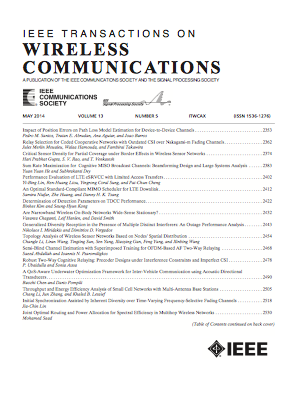波域双堆叠智能元表面辅助多用户大规模MIMO通信性能研究
IF 10.7
1区 计算机科学
Q1 ENGINEERING, ELECTRICAL & ELECTRONIC
引用次数: 0
摘要
虽然可重构智能表面(RIS)是一种很有前途的技术,用于塑造传播环境,但它由单层结构组成,在波束转向模式的数量方面存在固有限制。基于最近的革命性技术,即堆叠智能元表面(SIM),我们提出它不仅在大规模多输入多输出(mMIMO)设置中的基站(BS)端实现,而且在基站和用户之间的中间空间中实现,以根据需要进一步调整环境。为方便起见,我们称前者为BS SIM (BSIM),后者为信道SIM (CSIM)。为此,我们在BS和中间空间分别实现了基于波的组合和基于波的组合。具体来说,我们提出了一种减少开销的信道估计方法,这对sim辅助通信至关重要。其次,我们根据统计信道状态信息(CSI)导出了封闭形式的上行链路和频谱效率(SE)。值得注意的是,我们使用投影梯度上升法(PGAM)同时优化了BSIM和CSIM的相移。与以往的SIMs工作相比,我们研究了mMIMO设置下的上行传输,单相信道估计,中间空间的第二个SIM,以及两个SIM的同时优化。仿真结果显示了各种参数对总SE的影响,并证明了该优化方法相对于交替优化(AO)方法的优越性。本文章由计算机程序翻译,如有差异,请以英文原文为准。
Performance of Double-Stacked Intelligent Metasurface-Assisted Multiuser Massive MIMO Communications in the Wave Domain
Although reconfigurable intelligent surface (RIS) is a promising technology for shaping the propagation environment, it consists of a single-layer structure within inherent limitations regarding the number of beam steering patterns. Based on the recently revolutionary technology, denoted as stacked intelligent metasurface (SIM), we propose its implementation not only on the base station (BS) side in a massive multiple-input multiple-output (mMIMO) setup but also in the intermediate space between the base station and the users to adjust the environment further as needed. For the sake of convenience, we call the former BS SIM (BSIM), and the latter channel SIM (CSIM). To this end, we achieve hybrid wave-based combining at the BS and wave-based configuration at the intermediate space. Specifically, we propose a channel estimation method with reduced overhead, being crucial for SIM-assisted communications. Next, we derive the uplink sum spectral efficiency (SE) in closed form in terms of statistical channel state information (CSI). Notably, we optimize the phase shifts of both BSIM and CSIM simultaneously by using the projected gradient ascent method (PGAM). Compared to previous works on SIMs, we study the uplink transmission in a mMIMO setup, channel estimation in a single phase, a second SIM at the intermediate space, and simultaneous optimization of the two SIMs. Simulation results show the impact of various parameters on the sum SE, and demonstrate the superiority of our optimization approach compared to the alternating optimization (AO) method.
求助全文
通过发布文献求助,成功后即可免费获取论文全文。
去求助
来源期刊
CiteScore
18.60
自引率
10.60%
发文量
708
审稿时长
5.6 months
期刊介绍:
The IEEE Transactions on Wireless Communications is a prestigious publication that showcases cutting-edge advancements in wireless communications. It welcomes both theoretical and practical contributions in various areas. The scope of the Transactions encompasses a wide range of topics, including modulation and coding, detection and estimation, propagation and channel characterization, and diversity techniques. The journal also emphasizes the physical and link layer communication aspects of network architectures and protocols.
The journal is open to papers on specific topics or non-traditional topics related to specific application areas. This includes simulation tools and methodologies, orthogonal frequency division multiplexing, MIMO systems, and wireless over optical technologies.
Overall, the IEEE Transactions on Wireless Communications serves as a platform for high-quality manuscripts that push the boundaries of wireless communications and contribute to advancements in the field.

 求助内容:
求助内容: 应助结果提醒方式:
应助结果提醒方式:


